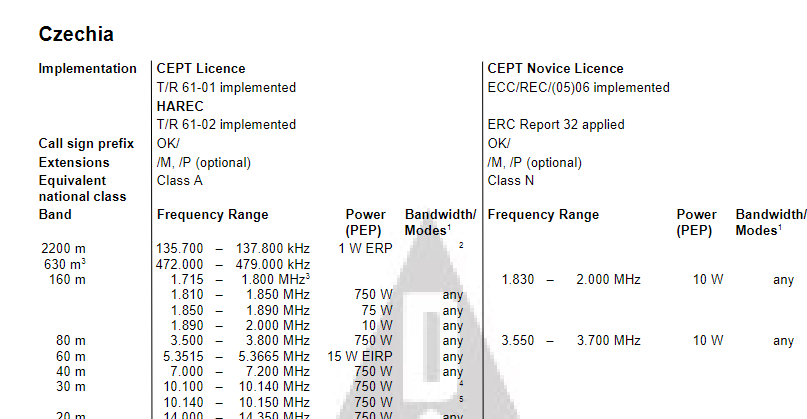Today I received feedback in which it is mentioned again that every radio amateur in the Czech Republic must apply for this permit if he/she/it wants to operate on 60m.
Odůvodnění
Úřad obdržel žádost o udělení oprávnění. Podmínka D.1 byla stanovena v souladu s plánem přidělení kmitočtových pásem (národní kmitočtová tabulka), kdy kmitočtové pásmo 5351,5–5366,5 kHz je přiděleno amatérské službě na podružné bázi (podružná služba) a kdy dále dochází ke sdílení s přednostními službami pevná a pohyblivá (kromě letecké pohyblivé). Úřad pro úplnost uvádí, že v souladu s ustanoveními 5.28 až 5.31 národní kmitočtové tabulky, využíváním rádiových kmitočtů v rámci podružné služby nesmí dojít ke vzniku škodlivého rušení vůči stanicím přednostních služeb, jimž jsou kmitočty již přiděleny nebo budou přiděleny později. Dále, využití v rámci podružné služby nemá nárok na ochranu před škodlivým rušením od stanic přednostní služby, jimž jsou kmitočty již přiděleny nebo budou přiděleny později a dále, že využití v rámci podružné služby si může nárokovat ochranu před škodlivým rušením od stanic téže nebo jiné podružné služby, jimž mohou kmitočty být přiděleny později než jim. Dále, v souladu s ustanovením 5.133B národní kmitočtové tabulky byla stanovena hodnota maximálního vyzářeného výkonu na 15 W (e.i.r.p).
Úřad žádosti vyhověl udělením předmětného oprávnění i z toho důvodu, že rádiové kmitočty v bodě B.1 nejsou uvedeny ve vyhlášce č. 156/2005 Sb., o technických a provozních podmínkách amatérské radiokomunikační služby. Z tohoto důvodu, před provedením úpravy příslušné vyhlášky, byly také stanoveny podmínky D.2 až D.4 za účelem dosažení účelu harmonizace pásma podle závěrů Světové Radiokomunikační konference 2015 a dále reflektování HF Managers Handbook IARU.
Justification
The Authority has received an application for authorisation. Condition D.1 was imposed in accordance with the frequency band allocation plan (National Frequency Table), where the frequency band 5351,5-5366,5 kHz is allocated to an amateur service on a secondary basis (secondary service) and where there is further sharing with the priority fixed and mobile services (excluding aeronautical mobile).
For completeness, the Authority notes that, in accordance with the provisions of clauses 5.28 to 5.31 of the national frequency table, the use of radio frequencies in the ancillary service must not cause harmful interference to stations
Priority Service stations to which frequencies have already been allocated or will be allocated at a later date. Furthermore, use in the secondary service shall not be entitled to protection against harmful interference from priority service stations to which frequencies are already allocated or will be allocated at a later date and further, that a use in a secondary service may claim protection from harmful interference from stations in the same or another secondary service to which frequencies may be allocated later than to them. Furthermore, in accordance with clause 5.133B of the National Frequency Table, the maximum radiated power has been set at 15 W (e.i.r.p).
The Authority granted the application by granting the authorisation in question also on the grounds that the radio frequencies in B.1. are not listed in Decree No 156/2005 Coll. on the technical and operational conditions of the amateur radio service. For this reason, prior to the modification of the relevant Decree, they were also conditions D.2 to D.4 were set in order to achieve the purpose of harmonisation of the band according to the conclusions of the World Radiocommunication Conference 2015 and to reflect the IARU HF Managers Handbook.
73 Marcel DM3FAM
